Menus
- What you must remember
- Themore
- Theless
- Prices
- Make yourKawasaki KX 450 F 2015
- Opinion
- Replaces
- The technical aspect
- Competitors
- Gallery
- Related articles
The KX specifications can be summed up in a few words: leading intermediate to expert pilots to victory. It has not changed since the creation of the KX forty years ago. With 32 AMA Supercross titles to their credit – a record for all manufacturers – the KX have long proven that they are the caliber of champions.. In addition to its renowned performance in terms of engine and chassis, a number of advanced technologies and “firsts”, and adjustments for 2015, make this new model KX 450 F formidable.
The liquid-cooled 449 cc 4-stroke mono delivers its bite to the entire tachometer. The highly usable power range and responsive acceleration unleash a torrent of torque that allows pilots to apply the throttle from low revs. Thanks to parts and settings inspired by competition machines, such as the high-performance piston with internal bridge cap (inaugurated on a production model by the KX 450 F 2010), its performance is maximum right out of the box! Thanks to the redesigned piston cap and new ECU settings, the 2015 version features a more “punchy” engine that revs up faster. In addition, the compression ratio has been increased from 12.5 to 12.8: 1.
Launch Control mode: how to do the holeshot
For a long time, cross-country KX have been inspired by factory techniques to offer pilots masterful performance without special preparation. This Launch Control mode is precisely one of those features that gives drivers a head start right from the starting grid. With the push of a button, the pilot can activate a separate map of engine settings that increases the chances of getting off to a good start in a race on slippery ground: by delaying the ignition timing, the Launch Control mode allows the tire rear to regain grip in a low traction situation, and therefore the pilot to concentrate on his trajectory.
– This mode is activated by pressing the Launch Control button, located on the left stalk, for at least two seconds (an indicator light next to the button will then flash rapidly to confirm to the pilot that the mode has been activated.)
– Launch Control mode works on 1st and 2nd gears (and in neutral). As soon as the pilot passes 3rd, the system is automatically deactivated and returns to normal mapping.
– The technical characteristics of this system are identical to those of the factory Kawasaki racing in AMA Supercross.
Ease of engine adjustments: Direct injection parameters (3 maps to choose from)
Thanks to the new DFI direct injection couplers, adjusting engine settings to driving conditions has never been easier: just plug in, and you’re done !
– Instead of a single engine map, the new UCE has three (four including Launch Control mode).
– The original settings for the three maps are: Standard (normal conditions), Hard (difficult conditions) and Soft (easy conditions). Using the supplied DFI couplers, the rider can easily switch from one map to another to adapt the settings to the driving conditions. Simply plug in one or the other of the 4-pin couplers to activate the corresponding mapping. (The location of the plug, to the right of the steering column, allows easy access without any dismantling of parts.)
– The optional KX FI injection calibration set can be used to reprogram the three maps
Injection system without battery
Specially designed for cross country machines, the injection power supply incorporates a small and light ECU and operates without a battery, in order to avoid unnecessary overload. In addition, it is no longer necessary to make engine adjustments depending on the condition of the track and weather conditions..
Factory-type components and preparation for the chassis
The KX 450 F’s aluminum perimeter frame is a narrow, lightweight structure made up of forgings, extrusions and castings. The balance and the settings of the chassis have been studied for experienced pilots. The position of the center of gravity and the main dimensions (swing arm axle, gearbox output pinion and rear wheel axle) were chosen so that the rear tire propels the machine, instead of compressing the rear axle to the acceleration. To add to the already recognized qualities of the KX 450 F: stability at high speed, maneuverability and simplicity of ergonomic adjustments when racing, the 2015 model is now equipped with a new SFF-Air TAC fork for faster driving..
Sophisticated suspension technology: SFF-Air TAC (Triple air chamber)
The KX 450 F is equipped with the new SFF (split-function) -Air TAC (Triple air chamber) Showa fork. The factory-type fork is very light and very stiff, for a more stable ride. Designed for intermediate to expert riders, the new fork perfectly absorbs shock at high speeds, making it easier to ride faster. Many other advantages:
– high rigidity
– great lightness
– low friction
– heat effects limited by the damping element
– precise adjustments possible by simply changing the air pressure
– Easy settings
– New: Independent damping and shock absorption functions:
Left fork tube: damper element
Fork straight tube: spring (air)
This configuration ensures both working flexibility and firm damping – a combination difficult to achieve with a conventional fork..
– New – Large inner tubes 49 mm in diameter (dimensions identical to those of our factory bikes) stiffen the fork, which accentuates the feeling of grip of the front wheel.
– New – The left and right tubes weigh only 7,950g between them, which constitutes an ultra-light structure (a reduction of approximately 840g compared to a conventional fork).
– New – The straight tube of the SFF-Air TAC fork has three chambers filled with compressed air that act like a spring, rather than coil springs (like on a conventional fork):
Internal chamber: main air spring
Outer chamber: secondary air spring
Balancing chamber: air spring balancing
– New – The internal chamber, at a standard pressure of 1000 kPa (range 600 to 1300 kPa), does most of the work, supporting at least 60% of the weight of the motorcycle.
– New – The outer chamber, with a standard pressure of 50 kPa (range 0 to 130 kPa), supports the inner chamber, as does the outer cylinder air chamber of a conventional fork.
– New – The balancing chamber, with a standard pressure of 900 kPa (range 530 to 1400 kPa), exerts a reactive force on the internal chamber for high driving comfort. When the fork is fully extended, the pressure of the internal chamber is minimum and that of the balancing chamber is maximum; when the fork is fully compressed, the pressure of the internal chamber is maximum and that of the balancing chamber is minimum.
– New – In the absence of the main springs, it is much easier to change the characteristics of the SFF-Air TAC fork than it is to calibrate the springs of a conventional fork. A simple adjustment of the air pressure makes it possible to adjust the “setting” of the TAC, without the hassle of disassembly. It is thus possible to carry out on-site adjustments according to the rider and the track, without additional parts and with minimal tools..
– New – A high pressure inflation pump adjusts the air pressure. (it is advisable to use a pump equipped with a pressure gauge and a flexible hose).
– New – This TAC air pressure adjustment covers the range of adjustments offered by optional springs on a conventional fork.
– New – In the compression phase, the compressed air strongly opposes the sinking, which helps to improve resistance to bottoming out. Conversely, in the relaxation phase, it offers less resistance which promotes road holding and the impression of grip on the ground of the front axle..
– New – In a conventional fork, the friction generated between the springs and the inner tubes is particularly felt on the second half of the travel. The removal of the main springs alone reduces this friction by about 20%. Thanks to the balancing chamber, the presence of a balancing spring is no longer necessary, which greatly contributes to the reduction of friction. The low friction results in a great flexibility of the work over the entire length of travel
– New – In addition, being able to use a larger shock piston (thanks to the elimination of fork springs) not only favors the progressiveness of the suspension work, but also allows for greater damping firmness. The shock absorber piston measures 30 mm in diameter (against 24 mm on a conventional fork).
– New – As on a classic fork, it is possible to adjust the compression and rebound.
– New – Balancing chamber pressure can be set as an initial preload.
– New – A super tough titanium coating on the outer surface of the inner fork tubes protects against abrasion wear. This dark blue coating also makes the tubes less susceptible to scratches and wear. The surface remains smooth longer, this limits friction (and grip) and thus improves the quality of riding.
– New – A self-lubricating alumite coating creates a hard, low friction surface on the outer tubes. The hard coating protects against abrasion wear on the inside of the tubes, so the surfaces stay smoother for longer, while the outside is protected against corrosion. The lubricating material of the coating makes it possible to improve the travel (in particular at the start of compression) and therefore the pleasure of piloting..
Racing-style rear suspension
– The rear shock absorber allows two separate compression damping settings: fast and slow.
– A self-lubricating alumite coating on the shock reservoir protects against abrasion wear and reduces friction for a smoother ride.
– New – New valve settings improve damping. Harder settings improve handling and stability at high speeds, as well as performance when landing jumps.
– The new Uni-Trak rear suspension system has a tie rod located under the swingarm, which increases the amplitude of travel and in turn allows finer adjustment..
– Extensive driving tests have made it possible to determine the ideal values for the travel ratios and the shock absorber settings ensuring maximum traction of the rear wheel.
Refined and modifiable riding position
With well-thought-out ergonomics, the KX450’s minimalist frame and trim refine the silhouette of the machine and make it particularly suitable for use on the track. Complemented by the handlebars and adjustable footrests, this natural riding position helps rider comfort for more speed.
Other competition elements of the cycle part
– New – Petal disc brakes are just one of the many factory-type parts found on the KX 450 F. Sleek new rotors underline the premium sporty style of the bike.
– New – Oversized 270mm front disc greatly increases front brake power, but it also improves brake control.
– A factory-style Renthal handlebar (standard type) in aluminum is delivered as standard.
– New – Front and rear axles have been lightened by 31g and 32g respectively.
– New – The thin walls of the rear frame tubes (t2.0 mm >> t1.8 mm) have been lightened by approximately 50 g.
Look “Factory”
With its minimalist bodywork, mudguard and racing plates, the KX 450 F is arguably the most radical machine in the paddock, and its factory-inspired graphics reflect its sharp performance. The green reflections on the suspension adjusters of the 2015 model, its oil tank cap and its alternator cover inspection plugs contribute to the characteristic Kawasaki look…
What you must remember
Themore
Theless
Prices
8 699 €
Price
nine
Compare
the credits
Make
yourKawasaki KX 450 F 2015
Estimate, calculate and compare the cost of insuring your motorcycle.
Calculate the cost of
insurance
Test the price of the motorcycle insurance specialist
Opinion
on 5 opinion
users
Read the reviews
Replaces
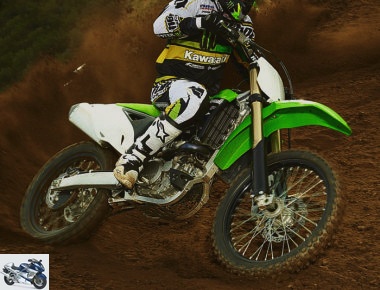
KX 450 F 2014
Model marketed in
2012
2013
2014
2015
2016
2017
2018
2019
2020
2021
The technical aspect
Kawasaki KX 450 F 2015
- Frame
- Frame: perimeter aluminum
- Tank: 6.2 liters
- Seat height: 960 mm
- Length: 2195 mm
- Width: 820 mm
- Height: 1275 mm
- Wheelbase: 1495 mm
- Weight in running order: 112.1 kg
- Train before
- Telehydraulic inverted fork Ø 49 mm, deb: 314 mm
- 1 disc Ø 270 mm, 2 piston caliper
- Front wheel:
80/100
– 21

- Transmission
- 5-speed gearbox
- Secondary chain transmission
- Rear axle
- Mono-shock absorber, deb: 315 mm
- 1 disc Ø 240mm, 1 piston caliper
- Rear wheel:
120/80
– 19
- Motor
- Single cylinder
in line
, 4 stroke - Cooling: by water
- Injection Ø 43 mm
- 2 ACT
- 4 valves
-
449 cc
(96 x 62.1 mm) - Compression: 12.8: 1
- Crit’air:
Detached pieces
exhaust
motor
fluid
electricity
filtration
braking
chain kit
Competitors
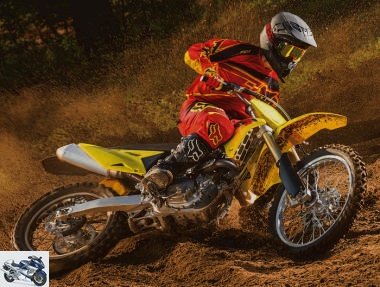
Suzuki RM-Z 450 2015
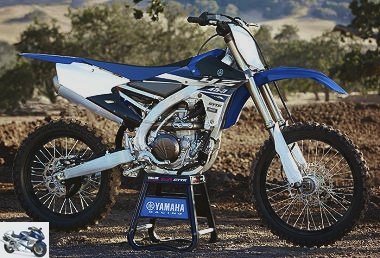
Yamaha YZ 450 F 2015
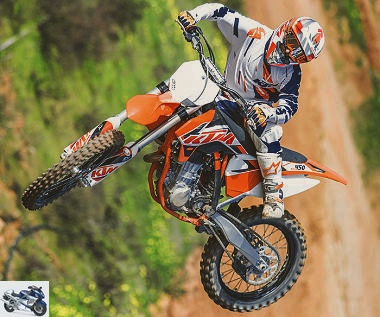
2015 KTM 450 SX-F
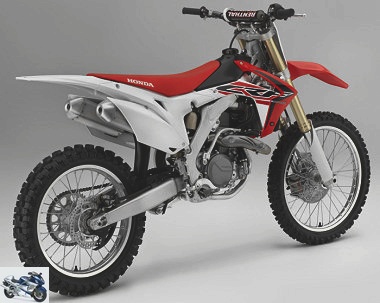
2015 Honda CRF 450 R
Gallery
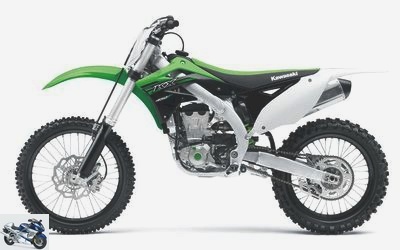
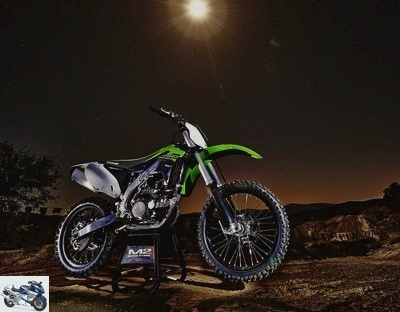
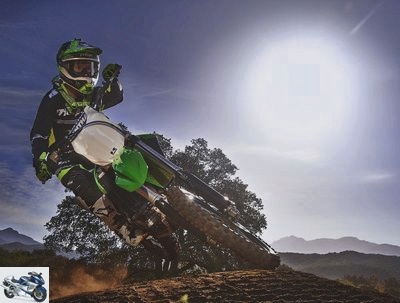
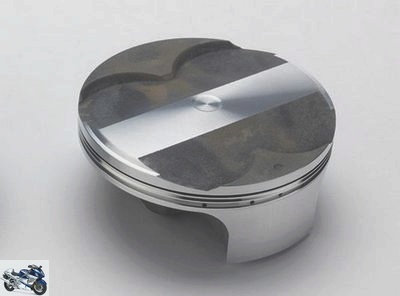
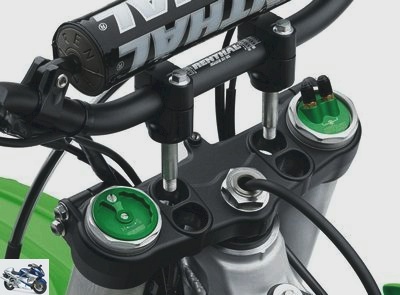
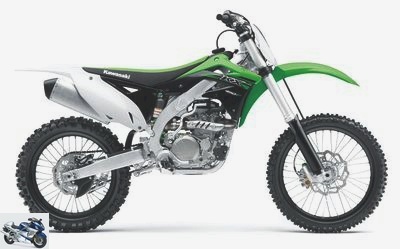
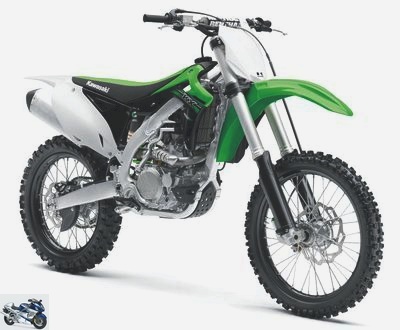
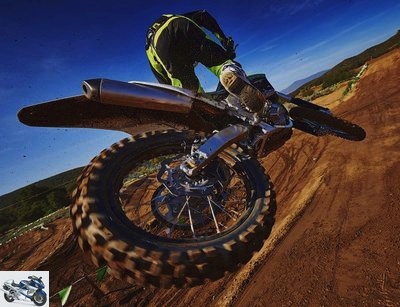
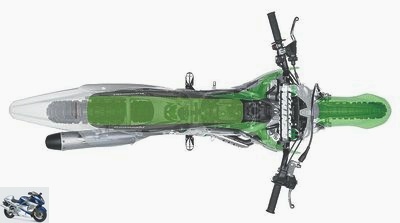
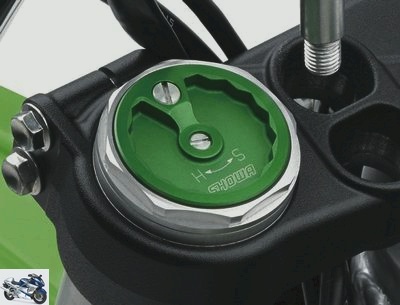


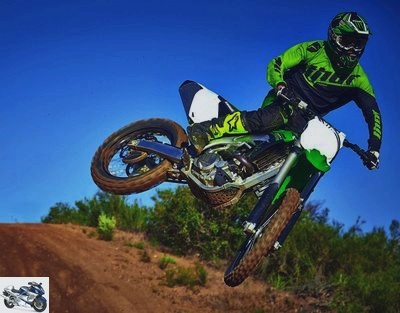
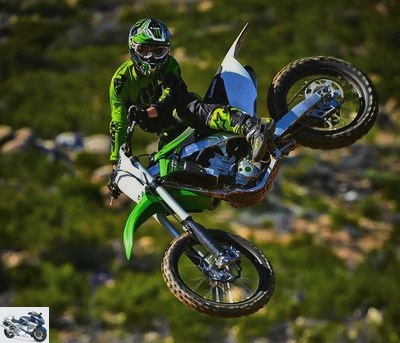
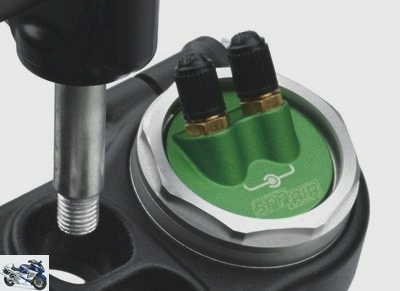
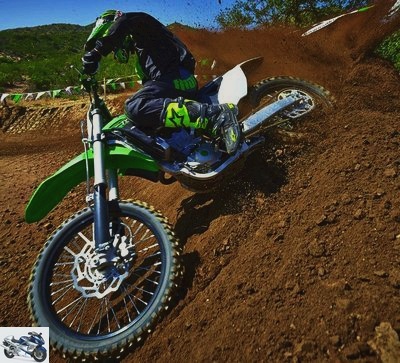
Related articles
-
Adjustable cockpit, Launch Contol, 3 engine maps, an injection calibration kit, the Kawasaki KX 450 F offers you one goal: to be ahead of the pack !…
-
All new, the KX450F receives the latest “Factory” developments for 2012. Multiple innovations such as the departure management mode, unprecedented on a…
-
Bad ! The S 1000 R is nothing less. When BMW comes to join in the brawl of the hyperfighters, it does so with the same will as when it entered the…
-
With the CRF 450 R 2015, Honda is offering its customers the opportunity to increase the chances of getting on the podium! This vintage marks significant…
-
The KX’s specifications haven’t changed since the brand’s launch over 40 years ago: leading intermediate to expert level drivers to victory. The KX 250 F…
-
All superlatives have been used to define H2R. Some minor changes will thus have difficulty finding an echo in the aura of this exceptional motorcycle….
-
It started with a breath coming from afar, where 4 perfect drops fell from a saber into the sea. From this rustling was going to be born a terror, a…
-
The appearance of the 636 does not eclipse the ZX-6R with supersport volume (600 cc max). As in the early 2000s, they coexist, each with its own…
-
Some motorcycles had familiarized even reached the stage of madness. The Kawasaki Ninja H2R goes beyond all of that. With this totally surreal…
-
Kawasaki Ninja 1000 ZX-10R KRT Replica 2020
The ZX-10R is always looking for power. Last year, its mechanics were entitled to the right care to gain watts. It passed a new stage with a revision of…